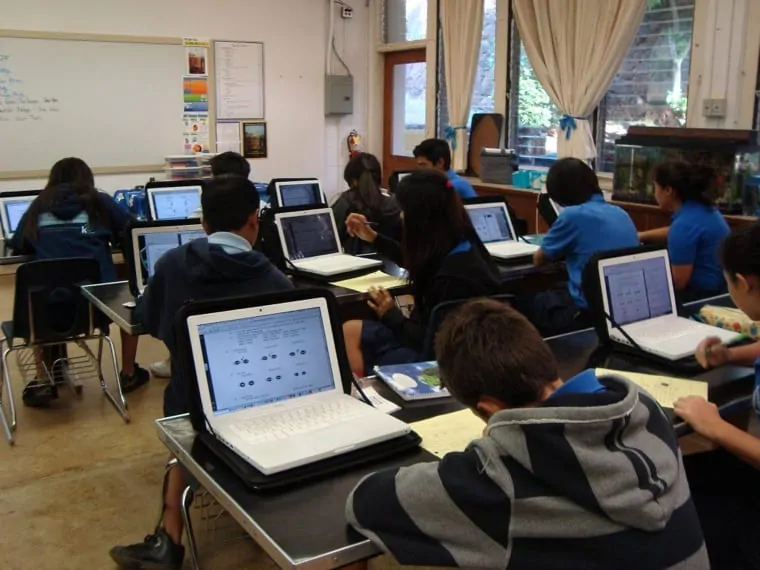As education evolves and starts to embrace rapid developments in technology, we’re starting to see new teaching methods being introduced to the classroom that takes advantage of this digital revolution.
One form of digital communication being increasingly exploited for learning purposes is blogging which in turn has led to an increased need for paid and free blog sites for students and teachers.
Blogging is a platform that has been widely used by individuals and businesses for a long time now, and its educational potential is increasingly being acknowledged.
If you’re thinking of setting up a blog for your class, here’s your guide to getting started with educational blogs for students free and paid.
You might also like:

Table of Contents
Our #1 Choice For Hosting Blogs
62% Off Exclusive Offer Applied at Checkout
Regularly
$6.95/mo
Starting From
$2.64/mo*
- Free 1 Year Domain Registration on Select Plans
- FREE SSL Certificate
- Drag-and-drop Website Builder
- E-commerce Ready
- 1-Click WordPress Installation

What do I mean by “classroom blogs”?

There are several possible ways of utilizing the power of blogging in a classroom context. These are the main ones:
- Teacher communications – using a blog to communicate school or class news with students and their parents.
- Teacher blogging about their subject – to encourage debate among students (perhaps even encouraging students to engage actively with the content by leaving comments with their opinions).
- Student blogging – either a shared blog to which each student can contribute under their own user profile or each student has their own blog for sharing their thoughts about a particular subject or subjects.
Which will best suit the needs of your classroom?
Benefits of educational blogs
1. Blogging allows students to express their opinion
Blogging helps students articulate their views and build a readership, which can be a very motivating experience for them. Sharing ideas on the internet can also put them in touch with like-minded individuals and with those who may challenge their ideas, which means that they may be required to defend their opinions (which is valuable preparation for the academic rigor of university).
2. Great experience for future university and job applications
Blogging demonstrates enthusiasm for the subject, and a willingness to share ideas with others, as well as developing enthusiasm for communicating ideas in a way that will prove useful beyond the classroom. It also teaches students about the importance of ‘responsible journalism’ such as backing up ideas with concrete evidence, citing research and so on.
3. Blogging about a subject is more engaging than reading textbooks
If students are to write about a subject on a public platform like a blog, they need to be completely familiar with the subject and comfortable expressing an opinion about it. This encourages a deeper understanding and greater engagement with the subject. Unlike when they write an essay that only the teacher will read, blogging gives their work an indefinite life beyond the classroom and invites others to engage with it.
Classroom blogs for students

So, you’ve decided that your class would benefit from blogging. But how do you go about finding educational blogs for students free, and then set one up?
The good news is that it’s never been quicker or easier to start classroom blogging, and thanks to the plethora of different blogging platforms out there, you need virtually no technical knowledge to do it.
Using a personal blogging site
There are numerous free blog sites for teachers that are not specifically designed for schools but do the job very well. They are usually free because they place small adverts at the bottom of your posts; if you want to get rid of these, there’s usually an option to pay to upgrade to ad-free.
Here are some of the best free blogging platforms for teachers (free unless stated otherwise) include:
- WordPress
- Blogger
- LiveJournal
- TypePad (not free)
These platforms, and others like them, guide you through the process of setting up a blog in a user-friendly way, making the whole thing straightforward and stress-free.
Best classroom blog sites for the education sector
These sites are similar to those above but are tailored specifically towards the education sector.
- Edublogs (best classroom blog site when multiple blog management is needed)
- Weebly for education (a good blogging site for parent involvement and accepting online assignments)
- Kidblog (designed for K-12 teachers to allow safe monitored and pre-approved publishing)
- QuadBlogging (Best option for interaction with other classes and schools)

Self-hosting (more advanced)
There are other blogging platforms – one of the most popular being WordPress.org – that involve ‘self-hosting’ – and if you don’t know what that is, it’s probably not the best option for you. Self-hosting gives you greater flexibility over the content of the blog, but it’s much more technical and not recommended unless you’re very comfortable with finding your way around the back end of a website (or you don’t mind sending every single post and edit to your IT department to take care of for you!).
If you’re an IT class learning about technical things such as coding, this might be a good educational experience in itself, but with so many much easier options, it isn’t going to be the ideal choice for most.
For more information about self-hosting a blog, read the tutorial on my homepage.
Decide before you set up your classroom blog:
To give your blog the best possible start, these are the questions you should be decided right at the outset.
Who will your audience be?
This is the most fundamental question, so address it first. Will your audience be the parents of the students in your class? The school community? Anyone interested in the subject? Other teachers? Only when you know for whom you’re writing can your blog find its voice.
What will you call the blog?
Thinking of a name for your blog can be more challenging than it sounds because popular names are likely to be taken already (and you’ll need a unique one for your domain name – the address people type into their web browser to read your blog).
If you only really intend your blog to be read within your school community, you could pick a name that means something within your school, such as the name of the school and class. If you want your blog to have a wider readership than just people in your school, you may want to pick a name with more general appeal, perhaps focusing on the subject itself rather than the name of your school or class.
What will you blog about?
Perhaps the most obvious use of a classroom blog is to write about the subject you’re teaching. This is a great way of supporting what you’ve been covering in classes. For example, an English class might blog personal interpretations of a particular poem you’ve been discussing in class.
Philosophy classes might want to put together student blog sites about a particular philosophical debate. English classes might want free blog sites for teachers to do a ‘Word a Day’ post explaining the origin of a particular word (or with a different student responsible for writing the post each day). The only limit to what you can blog about, and how to use the blog, is your imagination, and brainstorming topic ideas would be a great group task in class.
Who will blog?
As the teacher, are you going to be the only one posting on the blog? Will only the best student-written post get published each week? Or is each student going to have the opportunity to post on it as a matter of routine? If the latter, many blogging platforms allow you to set up user accounts and profiles for each contributor so that posts are marked with the author’s name.
You will probably want to be able to moderate posts and comments before they’re published, so bear that in mind, too.
How often will it be updated?
Maintaining a blog takes commitment, and it’s, therefore, a good idea to decide how often you will update it – perhaps a minimum number of posts per week. Will students take it in turns to write posts, and if so, how often? You could even come up with a sort of ‘content calendar’ to detail who writes what, and when.
Blogging tips for teachers and students
Lorem ipsum dolor sit amet, consectetur adipiscing elit. Ut elit tellus, luctus nec ullamcorper mattis, pulvinar dapibus leo.
Link out to external resources
It’s always a good idea to link out to other sites that have useful information that may be helpful for the reader. For instance, if you mention a particular piece of research, link to it. There’s usually a box you can tick when you add a link to have it open in a new window, which is a good idea because it keeps readers on your site as well as enabling them to access useful related content from other sites.
Track visits
Most blogging platforms have statistics that allow you to see how many people have been reading each of your posts, and even more detailed information such as how readers are finding your content, and, where in the world they are based.
These statistics are a useful guide, telling you which posts are most popular. If your goal is to gain a sizeable readership for your blog, from within the school community and beyond, this information tells you what kind of things your audience most enjoys, so you can provide them with similar types of content in the future.
Promote your blog
If you’re hoping that a blog will give your students a readership beyond the limited confines of your classroom, make sure you let other people know about it. This could be done by asking for the link to be included in school newsletters and on the school’s social media accounts. Make it easy for people to subscribe to your new posts by including a sign-up box so that people receive emails each time a new post is published.
Anything I’ve missed? Any questions? Leave a comment and I’ll get it answered as soon as possible.

Our #1 Choice For Hosting Blogs
62% Off Exclusive Offer Applied at Checkout
Regularly
$6.95/mo
Starting From
$2.64/mo*
- Free 1 Year Domain Registration on Select Plans
- FREE SSL Certificate
- Drag-and-drop Website Builder
- E-commerce Ready
- 1-Click WordPress Installation

Related articles:


